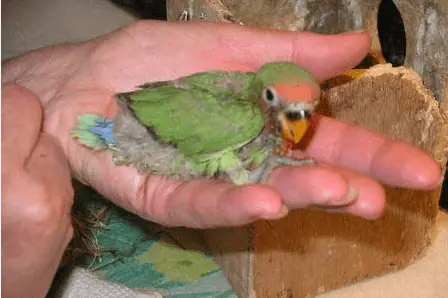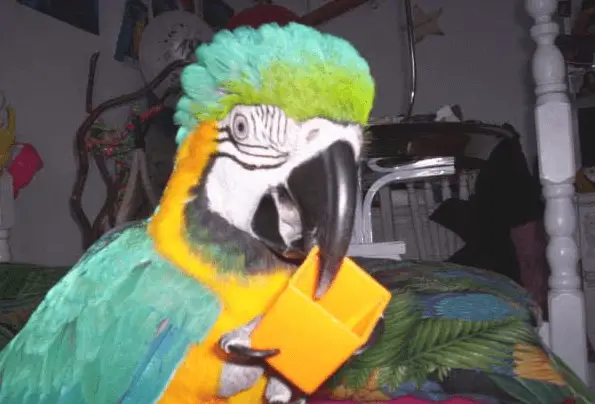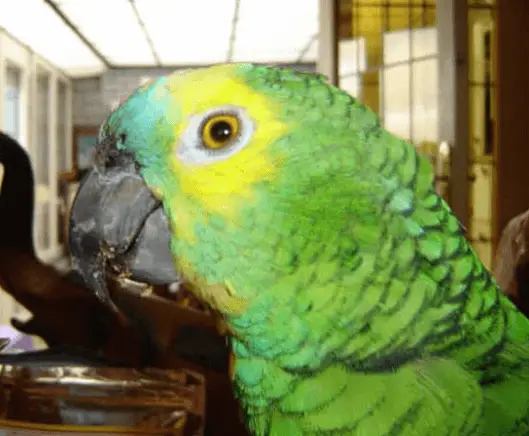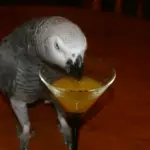
Parasites In Birds: An army of a few hundred little red lice invades the cage of Charlie the inseparable. Marie finally understands why he has been so nervous lately.
Once identified, unwanted people are quickly eliminated using the right medication and rigorous environmental disinfection. The problem was quickly resolved.
It is easy to make the right arrangements in front of an enemy that you can easily see. However, it is different when it comes to bacteria or viruses.
They are so small that it is impossible to detect their presence with the naked eye. They are all the more dangerous because they can invade a place without alarming anyone until birds are sick or simply die.
External parasites in birds
In the room or any other place where one or more sick birds or those carrying viruses live, there can be several hundreds of billions of viruses on the dust of walls, furniture, cages, curtains, etc.
They stick to your hands, clothes, hair, and shoes every time you visit this room. So you become, without your knowledge, a taxi for these infectious agents who hope that you will visit other places occupied by birds. They will then have the chance to infect them too. All of this is happening without your knowledge.
Any bird owner should be cautious of events involving an aggregation of birds. These are risky situations. They significantly increase the risk of spreading viral and other diseases, as not all birds present at these events are necessarily tested and proven to be free from contagious diseases. Caution is essential.
Three main viruses hold our attention in parrots

Parasites In Birds
- Pacheco virus
- The beak and feather virus
- The polyomavirus
A reliable screening test based on DNA testing for these viruses is available and should be performed in parrots showing symptoms of the disease as well as in healthy individuals.
Screening helps identify healthy birds and those carrying viruses. The latter category is particularly important to target, as it represents an insidious reservoir of infection.
This same type of test can also be used to determine if a part is contaminated. This involves taking a sample of the dust present on the walls or any other object.
This practice is particularly useful following an epidemic in order to determine whether the area that housed the sick birds has been adequately disinfected.
None of these viruses can be cured, although some medications can occasionally alleviate the discomfort they cause. It is therefore ideal to have any new bird that you want to obtain tested before it is put in contact with those you already own and whose health you know.
Hence the great importance of quarantining all new birds, in a place physically separate from the place where other birds of known good health live. Prevention is better than the outbreak of an epidemic which can cost dearly in terms of birdlife.
Vaccination is also a significant preventive measure. It is therefore ideal to have any new bird that you want to obtain tested before it is put in contact with those you already own and whose health you know.
Hence the great importance of quarantining all new birds, in a place physically separate from the place where other birds of known good health live.
Prevention is better than the outbreak of an epidemic which can cost dearly in terms of birdlife. Vaccination is also a significant preventive measure. It is therefore ideal to have any new bird that you want to obtain tested before it is put in contact with those you already own and whose health you know.
Hence the great importance of quarantining all new birds, in a place physically separate from the place where other birds of known good health live.
Prevention is better than the outbreak of an epidemic which can cost dearly in terms of birdlife. Vaccination is also a significant preventive measure. in a place that is physically separate from where other birds of known good health live.
Prevention is better than the outbreak of an epidemic which can cost dearly in terms of birdlife. Vaccination is also a significant preventive measure. in a place that is physically separate from where other birds of known good health live.
Prevention is better than the outbreak of an epidemic which can cost dearly in terms of birdlife. Vaccination is also a significant preventive measure.
This brief description of the three viruses discussed in this article will certainly convince you of the importance of doing everything possible to avoid exposure to your birds.
Pacheco virus

Parasites In Birds
The disease caused by this virus was first described in 1929 by M. Pacheco. He had observed an episode of acute and fatal hepatitis in Psittacidae residing in a zoo in Brazil, without knowing the exact cause of the disease. It was not until 1975 that a virus of the herpes family was formally identified as the causative agent of Pacheco’s disease.
The clinical signs of this disease vary depending on the virulence of the strain. A completely normal, healthy bird can die suddenly without any other symptoms.
If the parrot is infected with a strain of the virus that is a little less nasty, the course of the disease will be a little slower. He will be able to show different clinical signs:
depression, anorexia, diarrhea sometimes tinged with blood, regurgitation sometimes containing blood, green or yellow tinted urates ( secondary to severe damage to liver cells ), sinusitis, conjunctivitis, intense thirst, production of profuse urine, central nervous system damage ( loss of balance, seizures, tremors).
Death occurs on average two days after the onset of clinical signs. Rare parrots develop slightly less marked symptoms ( breathing problems, diarrhea, overproduction of urine ) and get away after a few weeks of discomfort.
These survivors become very dangerous to other parrots as they are now most likely carriers of the virus and will shed it intermittently.
A bird can thus remain completely normal for years, and even cohabit with other birds without making them sick until the day when, under the effect of stress, it begins to shed viruses and is responsible for the disease. death of its winged congeners.
A sick parrot very quickly contaminates its environment. Viruses are found in his respiratory secretions and stools. A study has shown that one gram of stool can contain between one and ten million viruses! The healthy bird is therefore easily contaminated by inhaling or ingesting viral particles.
Psittacines of all ages are susceptible to the disease. Treatment with a known antiviral ( acyclovir ) is successful in some individuals in reducing the severity of symptoms, but the death rate in a population remains high.
Not all Psittacidae species are susceptible to attack by the virus to the same degree. Old World parrots appear to be more resistant to infection than New World birds.
We also notice that macaws, amazons, and conures are very sensitive. There are even variations within the same group: sun and orange-fronted conures,
for example, tend to die quickly following exposure to the virus, while mitered, Monday and Patagonian conures are less affected by the virus. the virus. They are more likely to survive and later become carriers. Carriers have also been described in macaws and amazons.
Fortunately, the Pacheco virus is easy to destroy. Most regular disinfectants neutralize it and heat 56 ° C for 5 to 10 minutes. There is also an effective vaccine that can be administered to parrots who have to deal with unfamiliar birds.
The beak and feather virus

Parasites In Birds
Parasites In Birds( beak and feathers disease )
This debilitating disease caused by a circovirus was first described in species of Australian Psittacidae in the 1970s. The virus mainly attacks the feathers (the virus only damages the growing feathers.
(So the molting bird will quickly show abnormal feathers) but can also cause other symptoms depending on the age when the parrot was infected: very young birds ( less than a month old ) will show several days of depression.
It is a period of the active phase of molting therefore lesions to the feathers will be visible quickly ( hemorrhages, necrosis, and strangulation at the base).
Diseased feathers break and fall easily. Crop stasis and diarrhea often occur thereafter. Death usually occurs within 1 to 2 weeks after the onset of clinical signs.
In young parrots over a month old, fewer plumage abnormalities are noticed, as most of their feathers are already formed. Rather, these are signs of pneumonia, enteritis, and rapid weight loss that we notice. Death sometimes occurs without detectable damage to the feathers.
In the adult parrot, the course of the disease is rather chronic. At the rate of the molts, abnormal feathers appear. The bird gradually becomes bald.
Lesions to the beak ( abnormal lengthening, ulceration of the mouth ) and claws ( abnormal lengthening ) are sometimes present. The immune system is also affected. The bird is often bothered by secondary infections. Death occurs after several months or years.
Feather dust, stools, and nasal or oral secretions are contagious to birds that inhale or swallow them. The administration of acyclovir and an immunity stimulant improves the life of parrots somewhat, but the outcome is always fatal.
A vaccine is available in Australia but not yet in America. It is possible to disinfect a contaminated environment using bleach, 1% iodine, or heat ( 80 ° C for 1 hour ).
The polyomavirus
The virus has been widely described in parakeets, in which it causes what is commonly known as French moult. Feather abnormalities appear in young parakeets at weaning. Those that do not die often remain carriers without symptoms of the virus and serve as a reservoir of contamination for others.
All psittacines and finches are susceptible to polyomavirus.
In psittacines other than the parakeet, the virus causes different problems: the sudden death of young birds without any other symptoms. Death in 12 to 24 hours of young parrots having developed signs of depression, anorexia, crop stasis, regurgitation, diarrhea, dehydration, pale muscles, respiratory problems, and easy bleeding.
Chronic form in adult parrots with weight loss, intermittent anorexia, profuse production of urine, malformation of feathers, recurrent bacterial and fungal infections, neurological problems, and death.
The virus is found in feather dust and stool. Contamination occurs through inhalation or ingestion of viral particles. The virus is particularly resistant to disinfection. Bleach is one of the best ways to inactivate the virus.
An excellent vaccine is available and should be administered to any parrot likely to have contact with unknown birds as well as to all parrots that have been around a sick individual.




















